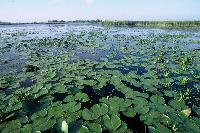400,000 ha of new Ramsar sites for Romania

Copyright © Michel Gunther / WWF-Canon
Seven new Wetlands of International Importance have been designated by the Ministry of Environment and Forests in Romania with the support of WWF. All sites are closely related to the Danube River meadows and the river's older arms, and have very high biodiversity value.
“The new sites represent 400,000 ha of new Ramsar sites”, said Orieta Hulea, Conservation Director of the WWF Danube-Carpathian programme. “This is another protection layer for this very valuable area”, Hulea said.
Romania now has a total of 19 Ramsar sites, covering an area of 1,156,448 hectares. Globally, the Ramsar Convention has 2,094 sites, totaling 205,035,960 hectares.
About the new Ramsar sites
Blahnita
The landscape of this site is represented by swamps, permanent lakes and sand dunes covered with acacias, poplars, oak forests and grasslands, inhabited by a rich and diverse fauna which finds exceptional conditions for nesting and breeding in the area. The site has been designated as a special protection area (SPA) under the Birds Directive for the protection of 16 bird species listed in Annex I, such as theHimantopus himantopus, the Chlidonias hybridaand the Egretta garzetta. The site is also important for the protection of many migratory species listed under the Bonn Convention as for example the Coracias garrulous, the Ixobrychus minutusand the Phalacrocorax pygmeus.
Borcea Arm (Bratul Borcea)
Located along a major migratory route, the Danube meadow site represents an important area for resting and feeding of a great variety of bird species. It contains many breeding populations of Accipiter brevipes,Acrocephalus melanopogon, Alcedo atthis and Ardea purpurea among others. During migration, the site is also important as a resting area for populations of Aythya nyroca, Ciconia ciconia, Haliaeetus albicilla andPandion haliaetus in their way from Russia to the Mediterranean and African countries. The Danube meadow shapes the landscape with lakes between sand dunes, marshes, fishponds, islands, canals and drainage channels, transforming the site into a cradle of biodiversity richness. The site provides a regulatory ecosystem service, reducing the Danube floods in the area.
Calafat-Ciuperceni-Danube
The site, situated in the southwestern part of the Oltenia Plain, very close to the Danube River, comprises three Nature Reserves for the protection of migratory and water birds under the Bonn Convention and the Birds Directive. Some of these species find ideal conditions for nesting, such as the Haliaetus albicilla, Ciconia ciconia and Burhinus oedicnemus. During the migration seasons, the site is also important for Tringa glareola, Pelecanus crispus, Platalea leucorodia and Plecadis falcinellus. The site plays a very important role in mitigating Danube flood damages.
Canaralele de la Harsova
Situated in the confluence of two Danube branches, Dunarea Veche and Bratul Borcea, on a major migratory route, the site represents an important area for resting and feeding of rare bird species. It provides shelter to important populations of protected birds catalogued under Annex I of the Birds Directive, as for example Accipiter brevipes, Circus macrourus and Pelecanus onocrotalus. The land situated in the surroundings of the Danube branches is covered by temporary lakes which also represent an important space for breeding and nesting of many other birds like Accipiter brevipes, Alcedo atthis and Botaurus stellaris. The site plays an important role in reducing and regulating the effects of Danube floods.
Danube Islands-Bugeac-Iortmac (Ostroavele Dunarii–Bugeac–Iortmac)
The site is a part of the Danube’s floodplain, where it has the largest width because the Danube splits into two branches which formerly enclosed large lakes. The site is situated on the route of an important migration corridor, so it is important as a breeding and resting place for several rare bird species. The landscape is specific to the meadows, with lakes between the sand dunes, marshes, shrub-dominated wetlands, fishponds and islands providing appropriate conditions for a great biodiversity.
Jiu-Danube Confluence (Confluenta Jiu-Dunare)
The site covers an important part of the Jiu river, which springs in the Southern Carpathians and flows into the Danube. A small part of the Danube meadow is also included in the site. Due to its length (over 60 km north-south), the site includes a great variety of ecosystems: oak forests, poplar forests, small lakes, old branches of the river, sand islands, dunes, marshes, channels, arable lands, etc. The complexity of these ecosystems provides favourable conditions for the presence of a high biodiversity. The site is also an Important Bird Area for many migratory birds, and it was declared a Special Protection Area (SPA) under the Birds Directive in 2007. In terms of its hydrological value, the site plays a very important role in groundwater level regulation.
Old Danube-Macin Arm (Dunarea Veche-Bratul Macin)
The site is part of the Danube meadow and is situated in an important migration corridor, providing breeding, resting and feeding shelter for many IUCN Red Listed bird species. The landscape is characterized by lakes between sand dunes, marshes, shrub wetlands, fishponds, islands, canals and drainage channels all very rich in biodiversity. The site is also important for conservation of tree galleries of Populus alba and Salix alba. Some of the factors adversely affecting its ecological status are drainages, wind turbines, urbanization, grazing, hunting and poaching. In terms of ecosystem services, the site plays a very important hydrological regulatory role in reducing the effects of the Danube floods.





